
After feuding with SpaceX for years in multiple FCC proceedings, Amazon finally cut the bow on its low Earth orbit (LEO) satellite internet constellation today by launching two Kuiper test satellites. The launch took place at the Cape Canaveral Space Force Station earlier today, and it marks the first of a constellation that will be made up of more than three thousand satellites. These satellites will orbit the Earth in obits similar to SpaceX's satellite internet constellation - the largest of its kind history. The Kuiper and Starlink satellite internet services will both work by providing users with an easily carriable satellite dish to allow internet access in areas that are underserved by traditional broadband internet providers.
Amazon Kicks Off Multi Year Launch Cadence For Kuiper Missions
Amazon's decision to launch the Kuiper satellites created a bit of controversy in the industry as it chose a wide range of launch services providers for its satellite constellation - except SpaceX. When it comes to launching LEO satellites, SpaceX's Falcon 9 rocket is the ultimate rocket due to its rapid cadence, easy availability and low costs.
Building a new LEO constellation requires a hefty investment in placing payloads in orbit before a sufficiently large customer base can be established to generate revenue and cover operating and production costs. Amazon plans to invest $10 billion in Kuiper as part of a package that includes launch contracts, terminal production and other investments.
Within the launch contract allocations for the Kuiper program, United Launch Alliance (ULA) has bagged most of the launches. Before he left the company, Jeff Bezos secured nine launches for ULA's Atlas V rocket, and ULA and Amazon have continued to work since then to ink an additional deal for 38 launches with a new rocket exactly a year after he left.

Related: SpaceX Concedes Starlink Altitude But System Changes Maintain Chokehold Over Amazon
Today's launch is an important part of Amazon's plans to manufacture its own satellite terminals since it will allow it to start making the 3,236 satellites that will be used to provide internet. Its decision to launch the spacecraft on the Atlas rocket instead of ULA's newer Vulcan Centaur was announced in August after the rocket's test article failed on the pad. The full Kuiper deployment plan is slated to last until 2029.
Amazon plans a nine month gap between the launch today and the launch of the first operational Kuiper satellites. Today's satellites were deployed at a 500 kilometer altitude, slightly lower than the typical altitude for such satellites. After the launch, which took place at 2:06 pm local time, the second stage of the Atlas V, Centaur, separated from the first stage roughly five minutes after liftoff.
Related: Amazon’s Satellite Double Standards Are Laughable Implies SpaceX
ULA's Vulcan Centaur rocket uses the same generation of second stage design as the Atlas but a new first stage called Vulcan. The engines for this rocket are made by Blue Origin, Jeff Bezos' rocket company that he set up more than two decades ago.
The test satellites will allow Amazon to evaluate its satellite terminals, the spacecraft themselves, and the Earth stations that form the third link in the satellite internet data transfer chain. SpaceX, which has launched more than four thousand Starlink satellites, also equips several of them with lasers to remove the need to communicate with a ground station frequently.
Kuiper's user terminals measure 11 inches in area and are one inch thick, and Amazon expects to build them for $400 apiece. Should today's satellites work as expected, then the retail giant has penned in the first production Kuiper satellite launch for H1 2024 and the start of beta testing for some commercial customers by the end of 2024.
WccftechContinue reading/original-link]




